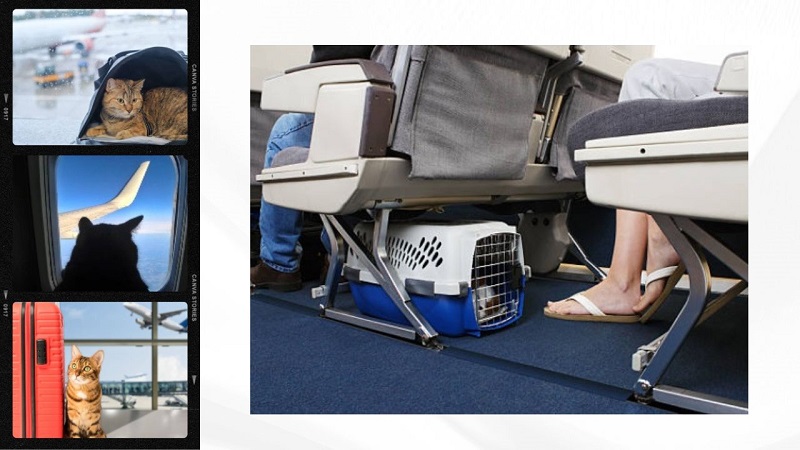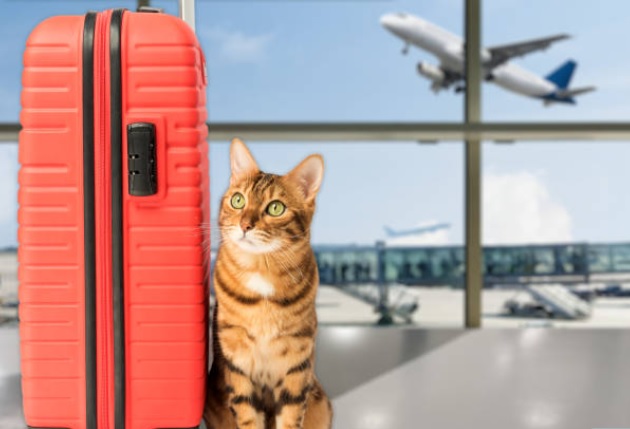Traveling with your beloved feline companion can be a wonderful adventure, but it can also be a source of stress for both you and your cat. In this comprehensive guide, we’ll provide you with essential Tips for a memorable travel with cat on plane. From preparing for the trip to navigating airport regulations and ensuring your cat’s well-being throughout the flight, we’ve got you covered. Let’s dive into the world of traveling with a cat on a plane!

In-Cabin vs. Cargo: Which Is Best for Flying with Your Cat?
In-Cabin Travel
If your cat meets the size and weight requirements, you may have the option to bring them into the cabin with you. Ensure your cat remains inside the carrier throughout the flight and is stowed under the seat in front of you. Do not open the carrier during the flight to prevent accidental escapes.
Cargo Hold Travel
If your cat is traveling in the cargo hold, inform the airline staff that your cat is on board. Ensure the carrier is properly labeled with your contact information and labeled as “Live Animal.” Follow the guidelines provided by the airline regarding drop-off and pickup locations.
Essential Tips for Stress-Free Travel With Cat On Plane
Before embarking on your feline adventure, it’s crucial to ensure a stress-free travel experience for your cat. Here are some essential tips to travel with cat on plane:

- Create a Familiar Environment:
Cats thrive in familiar surroundings, so it’s essential to bring their favorite blanket or bed to provide comfort and familiarity during the journey.
- Consult with Your Veterinarian:
Schedule a visit to your veterinarian before the trip to ensure your cat is in good health and up-to-date on vaccinations. Your veterinarian can also provide guidance on any necessary medication or sedation if needed.
- Identification and Microchipping:
Make sure your cat wears a collar with identification tags containing your contact information. Additionally, microchipping your cat provides an added layer of security in case they get lost during travel.
- Practice with a Carrier:
Introduce your cat to their carrier well in advance of the trip. Gradually acclimate them to spending time in it, making it a positive and safe place for them. This will help reduce anxiety during travel.
- Pack Pet Travel Essentials:
Bring essential items such as food, water, bowls, a leash, litter, and waste bags. Familiar toys or a favorite blanket can also provide comfort during the journey.
- Comfortable Carrier Selection:
Choose a well-ventilated and secure cat carrier that complies with airline regulations. The carrier should be spacious enough for your cat to stand, turn around, and lie down comfortably.
- Scent Familiarization:
Place a familiar-smelling item, like a piece of clothing you’ve worn, in the carrier to provide a comforting scent for your cat during the trip.
- Feeding Schedule:
Plan your cat’s feeding schedule accordingly. It’s recommended to feed your cat a light meal a few hours before the flight to prevent discomfort and reduce the likelihood of nausea.
Preparing and Packing for Flying with Your Feline Companion
Proper preparation and packing are crucial for a successful travel with cat on plane. Let’s explore some essential steps to ensure you’re well-prepared:
- Check Airline Policies:
Different airlines have varying policies when it comes to traveling with pets. Review the specific regulations, including carrier dimensions, weight restrictions, and documentation requirements for your chosen airline.
- Secure Reservations:
Inform the airline of your intention to travel with a cat as soon as possible. Airlines often have a limit on the number of pets allowed in-cabin, so ensure you secure your reservation early.
- Documentation Requirements:
Some airlines require documentation, such as a health certificate issued by a veterinarian, to confirm your cat’s good health. Research the specific requirements for your destination and airline.
- Arrive Early:
Arrive at the airport well in advance to allow ample time for check-in procedures and security screenings. This will help reduce stress for both you and your cat.
- Proper Identification:
Attach identification tags with your contact information to your cat’s collar and carrier. It’s also recommended to bring a recent photograph of your cat in case they get lost.
- Safety in the Airport:
Whenever possible, keep your cat securely in their carrier while in the airport. This will prevent any unexpected escapes and ensure their safety in the busy environment.
- In-Flight Requirements:
Familiarize yourself with the specific in-flight requirements and guidelines for traveling with cats. Ensure your cat remains in their carrier throughout the flight unless otherwise instructed by airline staff.
Ensuring a Smooth and Safe Travel with Your Cat On a Plane
During the flight, your cat’s comfort and safety should be your top priority. Here are some tips for ensuring a smooth and safe flight:
- Remain Calm and Reassuring:
Cats are highly sensitive to their surroundings and can often pick up on their owner’s emotions. Remain calm and reassuring throughout the journey to alleviate your cat’s anxiety.
- Keep the Carrier Secure:
Place the cat carrier under the seat in front of you during the flight, ensuring it is securely positioned. This will provide stability and prevent the carrier from shifting during turbulence.
- Avoid Opening the Carrier Mid-Flight:
While it may be tempting to comfort or check on your cat during the flight, it’s essential to avoid opening the carrier. This can lead to potential escapes and compromise both their safety and the flight experience.
- Minimize Noise and Distractions:
Reduce external noise and distractions by using a soft blanket or towel to cover the carrier. This can help create a sense of security and calm for your cat during the flight.
- Maintain Temperature Comfort:
Ensure your cat’s carrier is not exposed to direct airflow from the air conditioning vents. This helps maintain a comfortable temperature within the carrier during the flight.
- Hydration and Bathroom Needs:
Although feeding during the flight is generally not recommended, ensure your cat remains hydrated. Line the carrier with absorbent bedding and provide access to water to ensure they stay hydrated throughout the journey.
- Positive Reinforcement:
Offer verbal reassurance and reward your cat with treats or praise during and after the flight. This positive reinforcement can help create a positive association with air travel.
Navigating Airport Security with Your Feline Companion
Airport security can be a complex process, especially when traveling with a cat. Here’s a step-by-step guide to help you navigate airport security smoothly:
- Check Security Guidelines:
Research and review the specific security guidelines for traveling with pets at the airports you’ll be departing from and arriving at. This will help in understanding the necessary procedures.
- Contact TSA Cares:
Inform the Transportation Security Administration (TSA) in advance about your plans to travel with a cat. They can provide guidance on the security process and any additional considerations.
- Carry-On X-ray Screening:
Inform the security personnel that you are traveling with a cat before the carry-on items are screened. They may require you to hold your cat while the carrier goes through the X-ray machine separately.
- Pat-Down or Swab Test:
In some cases, security personnel may request additional screening procedures. Be prepared for the possibility of a pat-down or a swab test on your hands after handling your cat.
- Remain Calm and Cooperative:
Stay calm and cooperative throughout the security process. This will help facilitate a smooth experience for both yourself and the security personnel.
Conclusion: Travel with Your Cat on a Plane
Traveling with your cat on a plane can be a rewarding experience, strengthening the bond between you and your feline companion. By following the tips and guidelines provided in this stress-free guide, you can ensure a safe and comfortable journey for both you and your cat. Remember to plan ahead, prioritize your cat’s well-being, and remain patient throughout the entire process. With the right preparation, travel essentials, and a dash of love, you and your cat can embark on unforgettable adventures together. Bon voyage!
FAQ:
What type of carrier should I use for my cat when traveling on a plane?
When traveling with a cat on a plane, it’s important to use an airline-approved carrier that provides enough space for your cat to stand, turn around, and lie down comfortably. Choose a carrier that is well-ventilated and secure, with a sturdy construction. Soft-sided carriers are often preferred for cabin travel, while hard-sided carriers are more suitable for checked baggage. Ensure the carrier has a leak-proof bottom to prevent any accidents during the journey.
Are there any restrictions on bringing a cat on a plane?
Yes, there are certain restrictions when bringing a cat on a plane. Airlines may have specific regulations regarding the size and weight of the cat, the type of carrier allowed, and the number of animals permitted on board. Some airlines may also require health certificates or additional documentation for international travel. It’s crucial to check with the airline well in advance to understand and fulfill all the requirements.
How can I keep my cat calm during the flight?
A: To keep your cat calm during the flight, you can take several measures. Placing a familiar blanket or towel in the carrier can provide a sense of comfort. Additionally, you may consider using pheromone sprays or calming aids recommended by your veterinarian. It’s essential to avoid opening the carrier during the flight, as it may cause stress or escape attempts. Talking to your cat in a soothing voice and providing reassurance can also help alleviate anxiety.
Can I sedate my cat for air travel?
It is generally not recommended to sedate your cat for air travel unless specifically advised by your veterinarian. Sedation can affect your cat’s balance, breathing, and temperature regulation, which can be dangerous during the flight. If you believe your cat may require sedation, consult with your veterinarian for appropriate and safe options.
What should I do if my cat gets anxious or agitated during the flight?
A: If your cat gets anxious or agitated during the flight, it’s crucial to remain calm and composed yourself. Reassure your cat with a soothing voice and gentle strokes through the carrier. Avoid opening the carrier as it may lead to escape attempts. If the anxiety persists, inform a flight attendant or cabin crew member discreetly, as they may provide assistance or offer suggestions to alleviate your cat’s distress.
Are there any specific guidelines for international travel with a cat?
Yes, there are specific guidelines for international travel with a cat. Each country has its own regulations regarding pet importation, including required vaccinations, health certificates, and quarantine procedures. It’s essential to research and comply with the destination country’s requirements well in advance. Contact the embassy or consulate of the country you are traveling to for the most up-to-date information and to ensure a smooth travel experience for your cat.
Can I feed my cat during the flight?
It’s generally recommended not to feed your cat during the flight to prevent any digestive issues or motion sickness. However, you should provide water in a spill-proof container attached to the carrier, ensuring your cat stays hydrated throughout the journey. After the flight, you can offer food to your cat at the earliest opportunity to maintain their regular feeding schedule.
How do I acclimate my cat to a new environment after air travel?
A: After air travel, it’s important to acclimate your cat to the new environment gradually. Set up a designated area with familiar items such as their bed, toys, and litter box. Keep your cat indoors for a few days to allow them to adjust and feel secure. Provide plenty of love, attention, and reassurance to help them feel comfortable in their new surroundings.





Be the first to comment